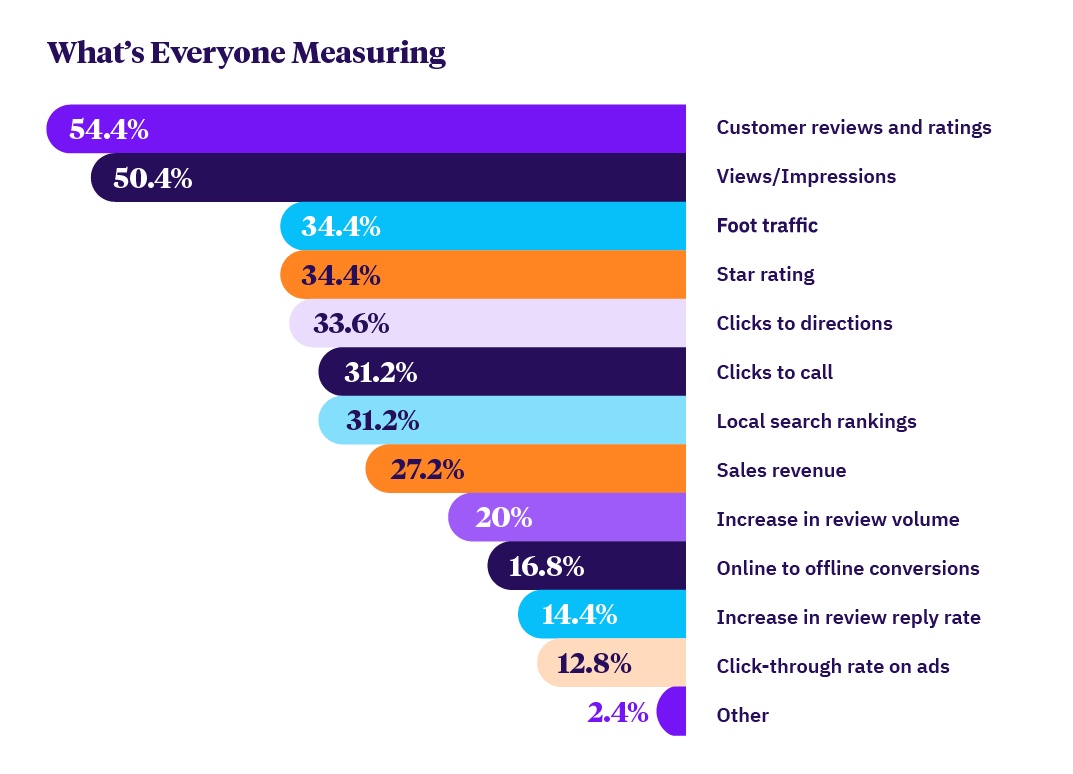
How Businesses (Should) Approach Location Marketing Revenue Attribution
Can you tie your marketing efforts to tangible revenue growth? Most marketers can’t—but let us show you a new approach to marketing revenue attribution!
As businesses always strive to grow, the challenge of measuring the return on investment (ROI) from their marketing efforts looms large. Our recent report went to the bottom of this, revealing a significant gap in connecting location marketing to tangible revenue growth.
Let’s explore the key findings around the current state of location marketing measurement, the challenges faced—and a glimpse into what’s next for revenue attribution!
The State of Location Marketing Measurement
Today’s marketers are feeling the heat, as revealed in our report, for which we asked hundreds of marketers in multi-location businesses how they currently measure the impact of their location marketing.
A striking**77% report increasing pressure to deliver revenue outcomes swiftly, while only 32% have established clear key performance indicators (KPIs)** to gauge their location marketing performance. This disconnect raises a critical question: How can marketers effectively link their location marketing efforts to financial results?
{{quote}}
Marketing Revenue Attribution
Marketing revenue attribution involves identifying which marketing efforts directly contribute to sales and overall business revenue. Accurate attribution not only enhances strategic planning but also justifies marketing budgets, ensuring that investments are aligned with revenue generation goals.
Metrics That Matter
Understanding which metrics hold the most weight in assessing location marketing effectiveness is crucial—especially since there are plenty to choose from.

Here's the catch: only 27% of marketers are tracking sales revenue directly linked to location marketing, although this disconnect can hinder budget approvals and impact strategic planning.
“Our survey shows that 51% of marketers in multi-location businesses are eager to ramp up their location marketing investments. Securing more budget might be challenging for most since fewer than a third have clear KPIs in place to track their efforts and even fewer are directly connecting those KPIs to sales revenue.” - Stéphanie Génin Chief Marketing Officer, Uberall
Roadblocks to Location Marketing ROI
Marketers face numerous obstacles in accurately measuring the ROI of location marketing initiatives:
- Data Overload: struggling to consolidate insights into a cohesive view.
- Lack of Resources: lacking in-house expertise and / or analytics tools.
These challenges create a landscape where businesses find it difficult to translate awareness metrics into real business outcomes, hindering the ability to justify marketing expenditures.

And did you know, or expect, that the size of a business impacts its ability to track ROI? Smaller businesses often rely on direct metrics, while larger enterprises leverage advanced analytics to connect the dots between online engagement and in-store visits.
The Future of Location Marketing Measurement
As location marketing evolves, there’s a pressing need for a fresh approach to revenue attribution. At the same time, the rapid pace of change in market conditions requires businesses to remain agile.
Integrating AI Effectively
Artificial Intelligence (AI) is transforming the marketing landscape, providing businesses with new ways to engage with customers and optimize their operations. By utilizing AI-driven tools**, businesses can improve efficienc**y while delivering tailored experiences.
Demonstrating Marketing Impact
Establishing key performance indicators (KPIs) is vital for measuring marketing success. By integrating analytics tools that track metrics such as customer engagement together with revenue attribution, businesses can provide concrete evidence of their marketing effectiveness.
- Visibility is all about how effortlessly your locations appear online when potential customers are searching for your offerings.
- Reputation reflects how customers perceive your brand online, influencing their trust and willingness to engage with your locations.
- Engagement measures how effectively you connect with customers across digital platforms, fostering interactions that can build loyalty and drive traffic.
- Conversions indicate the success of turning interested visitors into customers, showcasing how well your strategies drive sales and customer action.
Entering the Era of Location Performance Optimization
Uberall’s Location Performance Optimization (LPO) is a new approach that unifies visibility, engagement, reputation, and conversions into one cohesive plan to drive revenue impact at every location—and to optimize your location marketing strategy, you will have to shift your focus from isolated metrics to this revenue-centric mindset.
“If your SEO has no impact on your company’s bottom line, don’t call it SEO.” - Javier Bermúdez SEO Specialist, Barceló Hotel Group
Think of it as a location marketing funnel, calculating the ROI by dividing total revenue gains by investment costs, encompassing local SEO resources and advertising expenses. And you know it, key elements include managing your business listings and reviews effectively.
Reach out if you want to learn more about LPO, or LPS — a single, powerful metric combining visibility, engagement, and reputation data all tied to revenue performance.
“I highly recommend tracking and reporting on all aspects associated with reviews, including NPS and sentiment analysis trends over time to understand how real-world customers are experiencing your business, whether customer experience is yielding referrals, and where the business can improve to retain existing customers and earn new ones.”
Ready to Transform Your Business?
Connect with our partnership team to learn how Uberall can help you achieve similar results. Get a personalized consultation and discover the opportunities waiting for your business.
Resources











